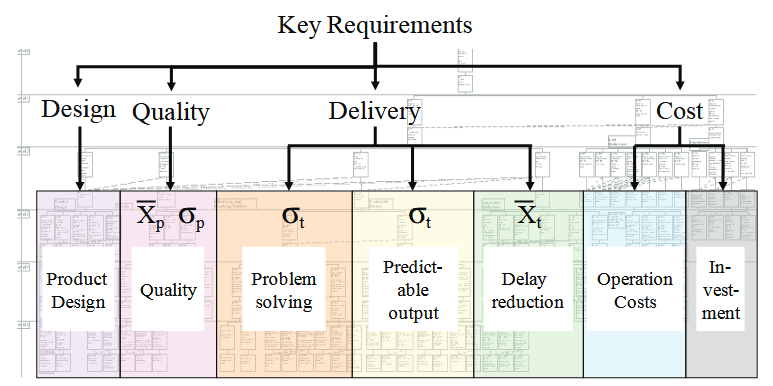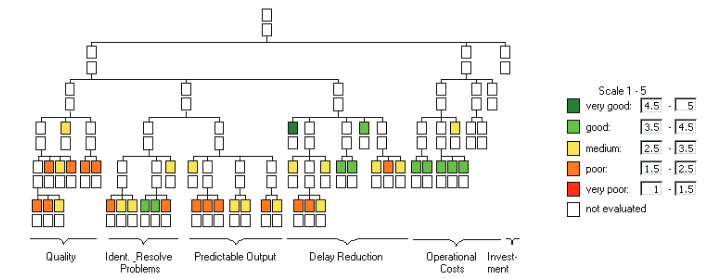ABSTRACT
Desired business results are the direct result of the system design. It is also theorized that the ‘thinking’ within an organization creates the organization’s ‘structure’ or design, which then drives the system’s ‘behavior.’ Achievement of enduring change in a system’s performance must begin with a change in the thinking of all the people in the enterprise, but especially that of leadership. In the absence of such a change in the thinking, the needed structural changes within a system may result in short-lived, point solutions, resulting in localized optimization of sub systems versus systemic improvement.
Axiomatic design, applied to a manufacturing system, is a design methodology to best reflect, understand and control the inherent complexity of large-scale integrated systems. System stability, and ultimately cost and span-time reduction, are the desired objectives of system design. This paper provides an overview of the manufacturing system design decomposition, and discusses the integrated use of data analytics to identify bottlenecks for system-improvement and use of the manufacturing system design decomposition to cost-justify resource allocation decisions for improvement.
MANUFACTURING SYSTEM DESIGN
Axiomatic Design and Robustness
Axiomatic Design was developed with the main purpose of establishing a scientific basic for design. This science base for design establishes both a natural and mathematical language to facilitate the collective understanding of the relationship between conceptual requirements (called, Functional Requirements) and the details of implementation (called Design Parameters or Physical Solutions).
- Application of Axiomatic Design to Design Manufacturing Systems
- System Design definition of Lean
THE MANUFACTURING SYSTEM DESIGN DECOMPOSITION (MSDD)
Application of Axiomatic design to large manufacturing systems has resulted in the development of logical system design map shown in Figure 1. The priority left to right order of the elements is reflective of the axiomatic design process as a partially coupled, path-dependent design.In contrast, Figure 1 illustrates that Lean is a result of a stable manufacturing system, which is a direct result of satisfying the stability requirements of each branch to minimize variation ( σ ) in product design( σd ), process quality ( σp ), identifying and resolving problems ( σt ) and predictable output ( σt).
As shown in Figure 2, the decomposition process, for example prioritizes product design, quality, problem solving, and predictable output over delay (i.e., throughput time / span or flow time in system) reduction, which has historically tended to be the focus of traditional “lean” manufacturing implementations. Lean manufacturing tends to treat issues within these elements as pure waste and focuses on span-time / throughput time reduction, wasted motion, and area organization, instead.
Figure 3 illustrates a complete analysis. This qualitative evaluation was useful in the sense that it helped focus the “system thinking” of the production team, and it created a common mental model which is critical to enterprise success. In 2002, Cochran and Hendricks took some of the elements of the system design from the full model; it was based on a pain-staking manual analysis to quantify the cost of not achieving each Product Deli very System (PDS) map Requirement. The PDS Map is the extension of the MSDD to include product development.
BIG DATA ANALYTICS IN MANUFACTURING SYSTEM DESIGN
The analysis of the elements identified above was difficult owing to the lack of sufficiently detailed data. However, the objectives of the prior research were limited by the available data and by the structure of available data. The goal of this prior effort was to provide sufficient data to support specific investments in specific solutions and attempted to calculate the cost / benefit of these investments. For example, an industrial engineer sampled part shortages for several months and collected data on the touch and support labor costs.
CONCLUSIONS
Today, big data analytics makes it possible to model the connections among various enterprise IT systems. This capability enables the study of variation in work performance on specific tasks or in particular areas with unprecedented insight. In other words, one can monitor the manufacturing system from the enterprise level down to the leaf or task level for the system design map defining the design of the enterprise of interest.
The ultimate goal of the data analytics is to be able to predict the performance of the system over a period of time based on given criteria, understand the impact of disruptions and variation within a system, and thus make the leap from a descriptive to a predictive system performance model. Big data analytics integrated with manufacturing system design should also provide insight into how a system could be improved under a what if analysis that particular system requirements are satisfied. In addition, it helps to improve the simulation for a well characterized manufacturing system where the impact of certain changes can be estimated.
In this paper, the authors provide an overview of the theory and methodology of the Manufacturing System Design Decomposition (MSDD); the results from the MSDD express sequence and path-dependencies, which may be evolved to accommodate predicted and unpredicted changes that occur to the manufacturing system. Big data analytics is a promising way to acquire data and to establish the cause effect model of system design relationships. An example of how big data analytics was applied to identify bottlenecks in operations from the perspective of quantitative performance evaluation was provided.
Source: Indiana University – Purdue University Fort Wayne
Authors: David S.Cochran | D Kinard | Zhuming M.Bi


